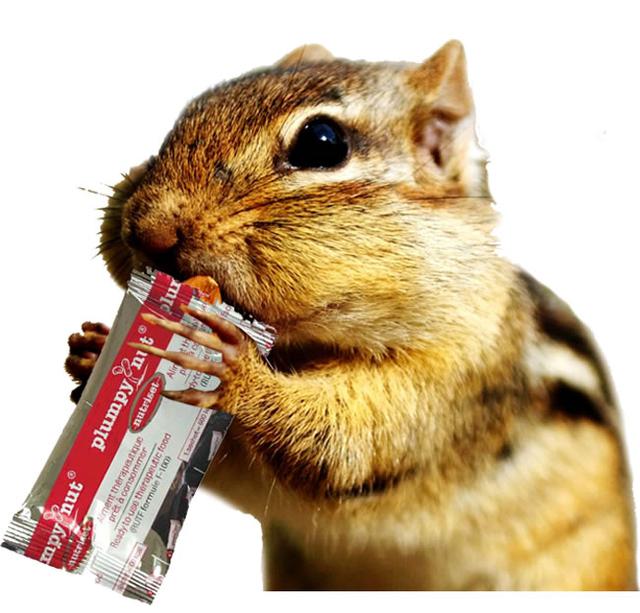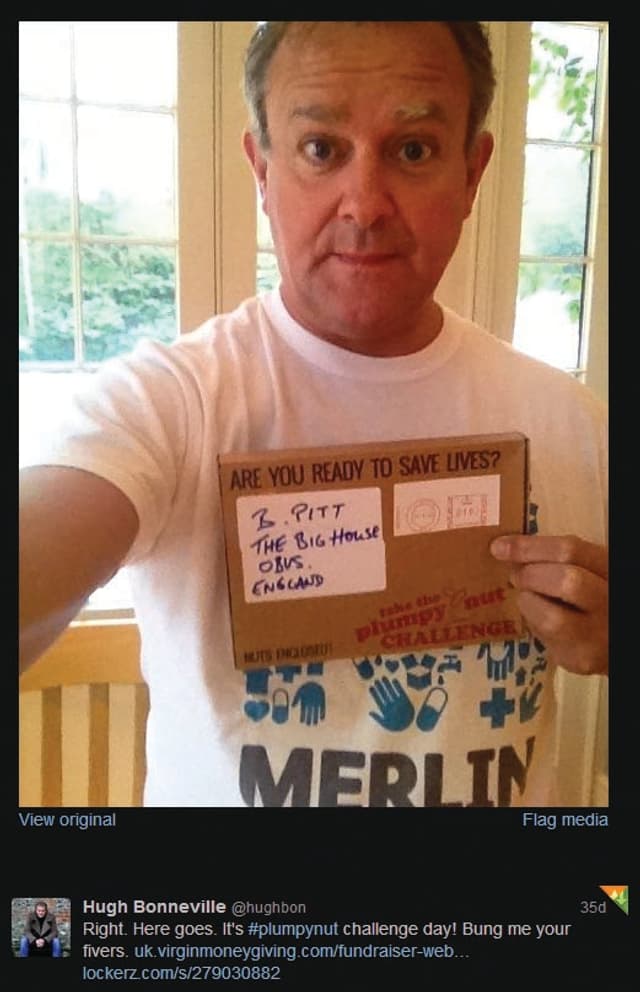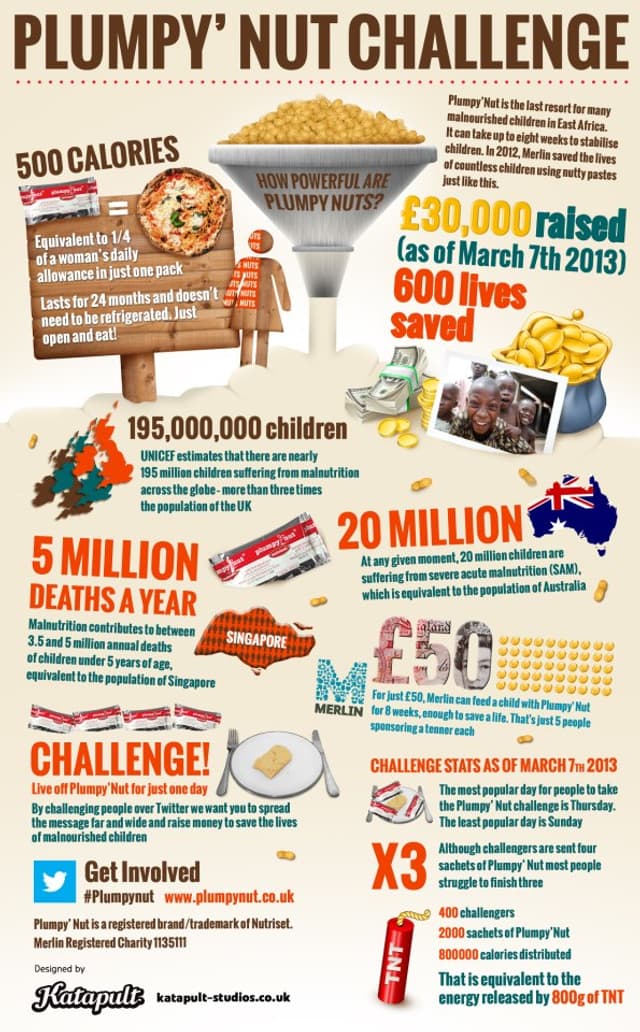Merlin’s Plumpy’Nut challenge: fun, easy, something anyone could do
- Exhibited by
- SOFII
- Added
- February 26, 2014
- Medium of Communication
- Online.
- Target Audience
- Individuals.
- Type of Charity
- International relief/development.
- Country of Origin
- UK.
- Date of first appearance
- January, 2013.
SOFII’s view
This amazing challenge from Merlin to live on Plumpy’Nut for just a day shows that by using social media wisely and by ‘friendraising’ as well as fundraising you will achieve marvellous results.
Creator / originator
Deniz Hassan, Simon Applebaum and Steve Ramsey now with Clockwork Pie.
Summary / objectives
To create an accessible challenge that requires no training and is doable by most people, from young children to older people. The low fundraising target of £50 per person meant the effort vs reward ratio was extremely high.
To penetrate a completely fresh market of the notoriously difficult 21-35 year olds.
Background
The roots of the challenge were very simple. Our web co-ordinator did a blog for our website about living off Plumpy’Nut for a day. In a team meeting we decided to turn it into a sponsored event. As with all great ideas, the exact moment is lost in the mists of time. But our then digital marketing manager, Deniz Hassan, grabbed the idea and developed it.
Plumpy’Nut is one product used to fight malnutrition. It is a simple sachet of nutrient rich peanut paste containing 200 calories that is given to malnourished children. The challenge involved living off four of these for a day – putting the participants in the shoes of the most malnourished children.
And why? Merlin wanted to delight rather than dictate. The concept gave people the option to help the cause while they had fun as opposed to creating an air of guilt. It was a completely two-way involvement that gave people an incentive to engage rather than just do.
Emotive photography, sounds, vision and stories are all great tried and tested techniques but we wanted something different. We wanted something much more tangible to really put them as close to the situation as possible and there’s no better way to convey a food crisis than with the taste and texture of food.
As a charity we, like most, are often guilty of making ourselves the centre of the universe mentioning ourselves during campaigns as often as possible. But doing this with a completely cold audience would only add a layer of complexity and a barrier to entry. The creativity needed to be simple, relevant and involving. It needed to link donor to beneficiary.
We also wanted it to be the first ever fundraising campaign to use, and make the most of, the spirit of sharing on Twitter. At Merlin we’ve talked about social media being used for ‘friendraising’ as much as fundraising and we wanted to connect with these friends and deepen their involvement by generating income
We decided to make the campaign completely cause lead and the best way to do this was by getting participants as close to the plight of the East Africa food crisis as possible. What we discovered shattered two myths: that social media cannot be used to raise money directly and that cold fundraising can’t produce a high ROI or net income.
There was no precedent to say that Twitter would be a good medium to raise funds. We were completely dependent on the work of other people to build the buzz.
The biggest organisational change was in the way we spoke and the tone of voice on our Twitter feed. Merlin has a strong following that achieves good levels of involvement. By bringing in such a radical change, there was great risk that we would alienate our existing donors in order to attract new supporters. This was managed by a gradual change prior to launch. We tweaked and tested in small steps ensuring we struck the right balance and didn’t confuse people with any sudden changes.
Special characteristics
The tone of voice was completely changed from formal and worthy to something more friendly and cheeky – an innovation for the charity sector. We’d already moved away from the ‘broadcast’ tone that so many charities use social media for and this was our opportunity to further develop the ‘Merlin voice’.
The tone of the entire campaign was ideal for the new, younger market that was targeted. It made people feel very comfortable and not overly deserving. The campaign was based around giving the Twittersphere a simple idea, giving them a fun, easy way to engage with a serious cause that was getting less and less media coverage. The simple proposition connected the participant to the beneficiary with an incredibly easy ask – raise money, publish great content and save lives.
By keeping the challenge Twitter-centric, Merlin created a highly active and enthusiastic community of fundraisers, engendering an extremely strong ‘contestant-get-contestant’ mentality. By giving the whole Twittersphere a target, we enabled a diverse group to come together and keep working even once their challenge had been done. The simple sign-up meant people were thanked live on Twitter and the microsite with their Twitter name, which reinforced the Twitter-centricity.
It appealed to early adopters. Without the power of large advertising campaigns it felt special – only people in the know found out about it by being well connected on Twitter.
Influence / impact
We exploited the current foodie trend of ordering healthy boxes of food by basing our packaging on popular designs. This really helped participants view their everyday lives side-by-side with their Plumpy’Nut day, enforcing the message.
As part of the tone we created ‘Mr Plumpy’ – your everyday, friendly chipmunk. The supporting email campaign from ‘Mr Plumpy’ gave it the ‘we-are-behind-you’ feel to the event and encouraged people to see the challenge through to the end.
The simple creative was only the start. We gave the Twittersphere the tools to become their own creative directors. We published the best Tweets, joined in the banter, gave them statistics and stories, created quick and easy content using new technologies like Vine and connected it all on plumpynut.co.uk.
Participants tweeted in droves; created hashtags, engaged with celebrities; took photos, video and audio; wrote blogs; ran school assemblies and contacted their local media themselves.
It encouraged a competitive, community spirit amongst tweeters, each looking to raise more money and produce better content.
Costs
Using social media meant the campaign cost only £6,000.
With zero promotional budget, Merlin seeded the campaign by identifying key Twitter influencers early on in the planning, ensuring they felt they had some responsibility and ownership of making the Plumpy’Nut challenge a success.
Participants became ambassadors, telling thousands of friends about Merlin and Plumpy’Nut. This meant they did the hard work themselves, encouraging others to do the same – creating fun content, starting conversations and spreading the word as far as possible.
The creative work, building the website, copywriting and fulfilment was all done in-house with a small team to keep costs as low as possible. Where we sought help was in managing the Twitter presence, working with an agency to help manage the volume.
Initially scheduled for one month, the campaign ran for longer – again giving the power to the contestants.
Results
The campaign raised £40,000, had a cold ROI of eight - and reached over one million people who had not previously heard of Merlin or the food crisis in Africa.





Also in Categories
-


















